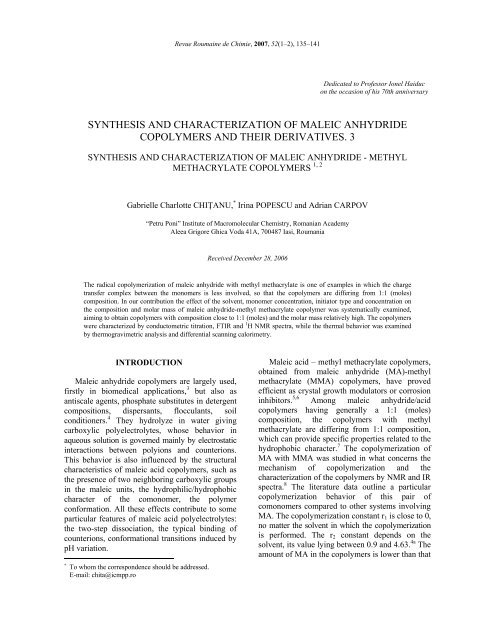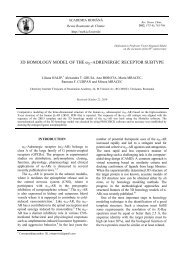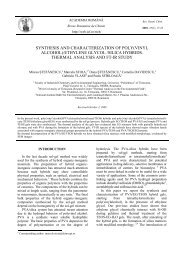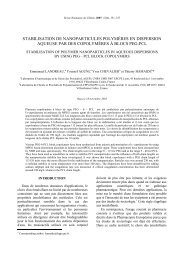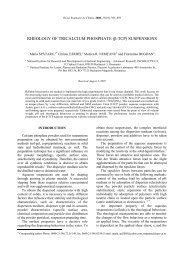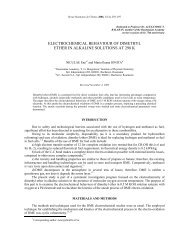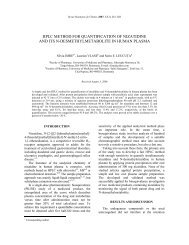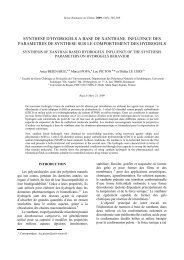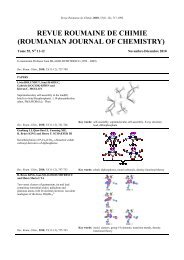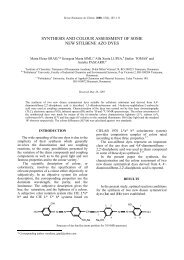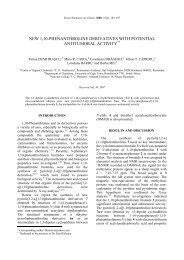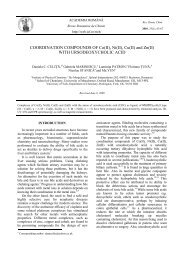synthesis and characterization of maleic anhydride copolymers and ...
synthesis and characterization of maleic anhydride copolymers and ...
synthesis and characterization of maleic anhydride copolymers and ...
Create successful ePaper yourself
Turn your PDF publications into a flip-book with our unique Google optimized e-Paper software.
Revue Roumaine de Chimie, 2007, 52(1–2), 135–141Dedicated to Pr<strong>of</strong>essor Ionel Haiducon the occasion <strong>of</strong> his 70th anniversarySYNTHESIS AND CHARACTERIZATION OF MALEIC ANHYDRIDECOPOLYMERS AND THEIR DERIVATIVES. 3SYNTHESIS AND CHARACTERIZATION OF MALEIC ANHYDRIDE - METHYLMETHACRYLATE COPOLYMERS 1, 2Gabrielle Charlotte CHIŢANU, * Irina POPESCU <strong>and</strong> Adrian CARPOV“Petru Poni” Institute <strong>of</strong> Macromolecular Chemistry, Romanian AcademyAleea Grigore Ghica Voda 41A, 700487 Iasi, RoumaniaReceived December 28, 2006The radical copolymerization <strong>of</strong> <strong>maleic</strong> <strong>anhydride</strong> with methyl methacrylate is one <strong>of</strong> examples in which the chargetransfer complex between the monomers is less involved, so that the <strong>copolymers</strong> are differing from 1:1 (moles)composition. In our contribution the effect <strong>of</strong> the solvent, monomer concentration, initiator type <strong>and</strong> concentration onthe composition <strong>and</strong> molar mass <strong>of</strong> <strong>maleic</strong> <strong>anhydride</strong>-methyl methacrylate copolymer was systematically examined,aiming to obtain <strong>copolymers</strong> with composition close to 1:1 (moles) <strong>and</strong> the molar mass relatively high. The <strong>copolymers</strong>were characterized by conductometric titration, FTIR <strong>and</strong> 1 H NMR spectra, while the thermal behavior was examinedby thermogravimetric analysis <strong>and</strong> differential scanning calorimetry.INTRODUCTION ∗Maleic <strong>anhydride</strong> <strong>copolymers</strong> are largely used,firstly in biomedical applications, 3 but also asantiscale agents, phosphate substitutes in detergentcompositions, dispersants, flocculants, soilconditioners. 4 They hydrolyze in water givingcarboxylic polyelectrolytes, whose behavior inaqueous solution is governed mainly by electrostaticinteractions between polyions <strong>and</strong> counterions.This behavior is also influenced by the structuralcharacteristics <strong>of</strong> <strong>maleic</strong> acid <strong>copolymers</strong>, such asthe presence <strong>of</strong> two neighboring carboxylic groupsin the <strong>maleic</strong> units, the hydrophilic/hydrophobiccharacter <strong>of</strong> the comonomer, the polymerconformation. All these effects contribute to someparticular features <strong>of</strong> <strong>maleic</strong> acid polyelectrolytes:the two-step dissociation, the typical binding <strong>of</strong>counterions, conformational transitions induced bypH variation.∗ To whom the correspondence should be addressed.E-mail: chita@icmpp.roMaleic acid – methyl methacrylate <strong>copolymers</strong>,obtained from <strong>maleic</strong> <strong>anhydride</strong> (MA)-methylmethacrylate (MMA) <strong>copolymers</strong>, have provedefficient as crystal growth modulators or corrosioninhibitors. 5,6 Among <strong>maleic</strong> <strong>anhydride</strong>/acid<strong>copolymers</strong> having generally a 1:1 (moles)composition, the <strong>copolymers</strong> with methylmethacrylate are differing from 1:1 composition,which can provide specific properties related to thehydrophobic character. 7 The copolymerization <strong>of</strong>MA with MMA was studied in what concerns themechanism <strong>of</strong> copolymerization <strong>and</strong> the<strong>characterization</strong> <strong>of</strong> the <strong>copolymers</strong> by NMR <strong>and</strong> IRspectra. 8 The literature data outline a particularcopolymerization behavior <strong>of</strong> this pair <strong>of</strong>comonomers compared to other systems involvingMA. The copolymerization constant r 1 is close to 0,no matter the solvent in which the copolymerizationis performed. The r 2 constant depends on thesolvent, its value lying between 0.9 <strong>and</strong> 4.63. 4a Theamount <strong>of</strong> MA in the <strong>copolymers</strong> is lower than that
136 Gabrielle Charlotte Chiţanu et al.corresponding to the molar ratio 1:1, so that the MA-MMA <strong>copolymers</strong> are soluble in solvents such asbenzene, toluene, etc, in which most <strong>of</strong> MAalternating <strong>copolymers</strong> are insoluble. 9 Thecopolymerization data have been explained usingthe classical terminal model, the penultimatemodel or the CTC model, depending mainly on thesolvent <strong>and</strong> initiator type. 8,10,11 The copolymerization<strong>of</strong> MA with other methacrylates such as tetradecylmethacrylate, tert-butyl methacrylate or trimethylsilylmethacrylate evidenced the same tendency to formnon-alternating <strong>copolymers</strong>. 12,13 It is to mentionthat the MA-MMA are quite biocompatible, beingexamined for bone cement formulations incombination with hydroxyapatite 14 or derivatizedwith disinfecting agents. 15The experiments presented in this paper havebeen aiming to obtain <strong>copolymers</strong> having thecomposition close to 1:1 (moles) <strong>and</strong> the molarmass relatively high. In this purpose a series <strong>of</strong>copolymerization reactions have been performedvarying the solvent, the monomer concentration,the nature <strong>and</strong> concentration <strong>of</strong> the initiator. The<strong>copolymers</strong> were characterized using the methodsgiven in the literature 16 or adapted to thiscopolymer. 17 EXPERIMENTAL PARTMaterials. The monomers, the catalysts, <strong>and</strong> the solventswere carefully purified before use according to the known18, 19methods.Methods. The MA-MMA <strong>copolymers</strong> were obtained byfree-radical copolymerization. The copolymerization reactionswere carried out in vessels flushed with nitrogen, the reactionmixture being also layered with nitrogen. The polymerizationshave been performed in solution <strong>and</strong> the <strong>copolymers</strong> havebeen recovered by precipitation in diethyl ether followed bypurification by repeated washing with diethyl ether :petroleum ether mixture <strong>and</strong> drying for 48 h at 40ºC <strong>and</strong>reduced pressure.The composition was determined by conductometrictitration 17 with 0.1 N aqueous NaOH in 1:1(vol) acetone:water mixture using a Radiometer CDM210 conductivitymeter <strong>and</strong> a CDC 641T cell. FTIR spectra were recorded onKBr pellet using a Vertex 70 Bruker Spectrometer <strong>and</strong> 1 HNMR spectra were recorded on a Cameca TSN 250 MHzspectrometer in d 6 -acetone. The average molar mass (M V ) wasestimated by viscometric measurements in acetone at 30±0.1 °Cwith an Ubbelohde viscometer. 16 The thermooxidativedecomposition under dynamic conditions <strong>of</strong> heating has beenperformed with a Paulik-Paulik-Erdey Derivatograph MOM-Budapest on 50 mg samples, at 12°C/min. Differentialscanning calorimetry analysis was performed with a PyrisDiamond DSC - Perkin Elmer instrument.RESULTS AND DISCUSSIONMost <strong>maleic</strong> <strong>anhydride</strong> <strong>copolymers</strong> have a 1:1(moles) composition <strong>and</strong> a regular, alternatingstructure, mainly due to the large participation <strong>of</strong> acharge transfer complex (CTC) formed by thecomonomers before polymerization. Unlike that, inthe copolymerization <strong>of</strong> MA with MMA the CTCis less involved 8,10 so that the composition isdifferent from 1:1 (moles), as shown in Scheme 1.For this reason we focused firstly on the copolymer<strong>characterization</strong> regarding the composition byconductometric titration, <strong>and</strong> spectrometricinvestigation by 1 H NMR <strong>and</strong> FTIR method.CH 3CH 3( (CHCH ) CH 2C )mC CCOOO O Onwith m≤nScheme 1 – Chemical structure <strong>of</strong> <strong>maleic</strong> <strong>anhydride</strong>-methyl methacrylate copolymer.Copolymer <strong>characterization</strong>. An example <strong>of</strong>conductometric titration curve <strong>of</strong> MA-MMAcopolymer having the composition MA:MMA=1:2.60 (moles) is given in Figure 1. Thetitration curve exhibits a typical shape similar toother MA <strong>copolymers</strong> 2,8 in which the end point canbe easily estimated.In the 1 H RMN spectrum presented in Figure 2it can be observed the peak at 3.8 ppm ascribed tothe protons <strong>of</strong> –COOCH 3 group <strong>and</strong> the largesignal at 1-2 ppm attributed to the α protons –CH 3in MMA units. 8 The peak centered at 3.4 ppm canbe attributed to the <strong>maleic</strong> protons, the signal fromthe CH 2 group protons being probably located inthe range 2.5-3.0 ppm. In the poly(methylmethacrylate) spectrum, the signal from α –CH 3 issplit in three peaks at 1.01; 1.08 <strong>and</strong> 1.20 ppm, dueto the sindiotactic, heterotactic <strong>and</strong> isotacticconfiguration, respectively. Cazé et al. 8 found, forthe MA-MMA copolymer, the same signal split at
Maleic <strong>anhydride</strong> <strong>copolymers</strong> <strong>and</strong> their derivatives. 3 1371.14; 1.20 <strong>and</strong> 1.24 ppm. In our case, this signal issplit in three peaks, at 1.08; 1.38 <strong>and</strong> 1.6 ppm,possibly due to the presence <strong>of</strong> sequences <strong>of</strong>several MMA units with different configurations.Because the signal <strong>of</strong> the <strong>maleic</strong> protons is not wellresolved, the estimation <strong>of</strong> the copolymercomposition is not possible. The peak at 6.5 ppmcomes from residual <strong>maleic</strong> acid. The broad signalcentered at 5.3 ppm could result from acyclo<strong>anhydride</strong>-enolic tautomerism mentioned forother MA <strong>copolymers</strong>. 2,20,21The FTIR spectrum <strong>of</strong> a MA-MMA copolymerwith MA: MMA=1:2.60 (moles), presented inFigure 3, confirms the information from the NMRspectrum. The characteristic b<strong>and</strong>s <strong>of</strong> the<strong>anhydride</strong> cycles can be noticed at 1860, 1784 cm -1(C=O) <strong>and</strong> 1090, 941 cm -1 (C–O–C). The b<strong>and</strong> at1728 cm -1 is characteristic to the C=O from estergroups <strong>of</strong> MMA units. The broad b<strong>and</strong> at 1246 cm -1 results from C–O–C bonds <strong>of</strong> <strong>anhydride</strong> cycles aswell as from C–O bonds <strong>of</strong> ester groups. The b<strong>and</strong>sat 1443 <strong>and</strong> 1379 cm -1 are due to the deformationvibrations <strong>of</strong> the CH 2 groups. The signals at 1150<strong>and</strong> 1443 cm -1 , assigned to some sequences <strong>of</strong>more than three units <strong>of</strong> MMA 22 , are in agreementwith the copolymer composition <strong>and</strong> the peaks inthe NMR spectra.The influence <strong>of</strong> solvent. Table 1 gathers theresults regarding the composition <strong>and</strong> molecularmass <strong>of</strong> the MA-MMA <strong>copolymers</strong> obtained indifferent solvents. The reaction yields werebetween 60 <strong>and</strong> 70%, but these values are notrelevant because almost all copolymerizationsproceeded in solution <strong>and</strong> the polymers wererecovered by precipitation. It is known that thepolymeric species with lower molar mass couldremain in the solvent-nonsolvent system.600c,µS/cm500400Fig. 1 – Conductometric titration curve <strong>of</strong> anMA-MMA copolymer.30020010000 1 2 3 4 5 6V baza , mLFig. 2 – 1 H NMR spectrum <strong>of</strong> theMA-MMA copolymer recorded at250 MHz.
138 Gabrielle Charlotte Chiţanu et al.Fig. 3 – FTIR spectrum <strong>of</strong> MA-MMAcopolymer.Table 1The influence <strong>of</strong> the solvent upon the composition <strong>and</strong> the molar mass <strong>of</strong> the MA-MMA copolymer.MA:MMA ratio= 1:1 (moles); C M =50 g/dL; initiator: benzoyl peroxide (BPO); reaction time: 8 hoursSolventDielectric C BPO , t , ° MA:MMA ratio in M v *constant %copolymer (moles)Dichloroethane 10.4 0.5 80 1:1.34 32000Acetone 20.7 1.0 56 1:1.44 38000Acetonitrile 37.5 1.0 80 1:1.53 40000Dioxane 2.2 0.5 80 1:3.04 43000Cyclohexanone 18.3 0.5 80 1:1.49 54500Ethyl acetate 6.0 0.5 77 1:1.91 71000Butyl acetate - 0.5 80 1:2.38 -2-butanone 18.5 0.5 80 1:1.52 48500* In literature there are data concerning the determination <strong>of</strong> molar mass using the Mark-Houwink-Sakurada equation with K=12.4×10 -5 dL/g <strong>and</strong> a=0.69. These values must be used with caution becausethe composition range for which the data are recognized was not specified. 16It can be observed that the <strong>copolymers</strong>synthesized in solvents with a higher dielectricconstant have a composition closer to 1:1(moles).This suggests that, by the solution copolymerizationthe charge transfer complex (CTC) between thetwo comonomers does not play an important role,in accordance to the results obtained by otherauthors. 8,10The influence <strong>of</strong> the monomer concentration.(C M ) on the molar mass <strong>of</strong> the MA-MMAcopolymer synthesized in 2-butanone is presentedin Table 2.Table 2The influence <strong>of</strong> C M on the molar mass <strong>of</strong> the MA-MMA <strong>copolymers</strong> synthesized in 2-butanone.Initiator: BPO; C BPO = 1%; MA : MMA ratio= 1:1(moles); temperature: 80°C; reaction time: 8 hoursC M , g/100mL Molecular mass* MA:MMA ratio in thecopolymer(moles)100 47000 1:1,5250 33000 1:1,4933,3 21500 1:1,4820 18500 1:1,58* See Table 1
Maleic <strong>anhydride</strong> <strong>copolymers</strong> <strong>and</strong> their derivatives. 3 139The influence <strong>of</strong> the initiator. Table 3 presentsthe influence <strong>of</strong> the initiator nature <strong>and</strong>concentration on the molar mass <strong>of</strong> the MA-MMAcopolymer obtained in 2-butanone. Three radicalinitiators were used, namely BPO, 2,2’-azobisisobutyronitrile (AIBN) <strong>and</strong> lauroyl peroxide(LPO).Table 3The influence <strong>of</strong> the nature <strong>and</strong> concentration <strong>of</strong> the initiator to the molecular mass <strong>of</strong> the MA-MMA copolymer. Solvent:2-butanone; MA-MMA ratio = 1:1(moles);C I – initiator concentration, g/100g monomers; temperature: 80°C; reaction time = 8 hoursInitiator C I , % C M , g/100mL M v *BPO 0,5 100 54500BPO 1,0 100 47000AIBN 0,5 100 38000AIBN 1,0 100 31000LPO 1,0 100 25500BPO 0,5 50 37000BPO 1,0 50 33000AIBN 0,5 50 38500AIBN 1,0 50 22000* See Table 1In the case <strong>of</strong> MA-MMA copolymerization, thenature <strong>and</strong> concentration <strong>of</strong> the initiator influencein a relatively small extent the molar mass <strong>of</strong> the<strong>copolymers</strong>. The values vary not so much, between22000 <strong>and</strong> 54500. However, it can be noticed thatthe highest M v values are obtained by using theBPO as an initiator. The monomer <strong>and</strong> initiatorconcentration influences on the M v in a qualitativeaccordance with the radical polymerization theorythat is, M v increases with the increase <strong>of</strong> themonomers concentration <strong>and</strong> decreases with theincrease <strong>of</strong> the initiator concentration.Thermal <strong>characterization</strong> <strong>of</strong> the <strong>copolymers</strong>.The thermal behavior was analysed bythermogravimetric analysis <strong>and</strong> differential scanningcalorimetry, in order to get useful information forthe further applications, e.g. as membraneprecursors or partner for composite materials.Figure 4 presents the thermogram <strong>of</strong> the MA-MMA copolymer having the composition MA:MMA=1:2.60 (moles). The decomposition takesplace in several stages, as following (T m is thetemperature corresponding to the maximum rate <strong>of</strong>weight loss):Stage Temperature range, °C T m , ºC Weight loss, %I 30-100 76 0.6II 100-240 145 5.2III 240-440 344 80IV 440-560 528 11.2The first decomposition stage can be assignedto the loss <strong>of</strong> moisture from the copolymer, theamount <strong>of</strong> absorbed water being relatively low, inaccordance to the hydrophobic character <strong>of</strong> theMMA. The second step can be due to the loss <strong>of</strong>chemically bound water, when the eventuallyhydrolyzed MA units are transformed in <strong>anhydride</strong>cycles. The third stage <strong>of</strong> decomposition, between240 <strong>and</strong> 440°C corresponds to an important loss <strong>of</strong>weight – 80% – <strong>and</strong> could be mainly due to thedepolymerization <strong>of</strong> the MMA small blocks (<strong>of</strong>course, this assertion should be confirmed bymeans <strong>of</strong> additional methods). The decompositiontakes place up to the almost complete degradation<strong>of</strong> the copolymer (97%). It is to be noticed theaccordance <strong>of</strong> our results regarding the main steps<strong>of</strong> decomposition II <strong>and</strong> III with the results <strong>of</strong>Bhuyan <strong>and</strong> Dass. 23Figure 5 presents the DSC diagram <strong>of</strong> the MA-MMA copolymer having the composition MA :MMA=1:2.60 (moles). Glass transitiontemperature T g is 125°C, lower than those <strong>of</strong> thealternanting <strong>copolymers</strong> <strong>of</strong> MA with vinyl acetateor styrene. 24
140 Gabrielle Charlotte Chiţanu et al.Fig. 4 – The thermogram <strong>of</strong> MA-MMAcopolymer.Fig. 5 – The DSC diagram <strong>of</strong> the MA-MAM copolymer.
Maleic <strong>anhydride</strong> <strong>copolymers</strong> <strong>and</strong> their derivatives. 3 141CONCLUSIONThe experiments for the obtaining <strong>of</strong> the MA<strong>copolymers</strong> with MMA have evidenced theinfluence <strong>of</strong> the solvent on the copolymercomposition in a way that confirms the reducedparticipation <strong>of</strong> the CTC in the copolymerizationreaction. The monomer concentration, the nature<strong>and</strong> concentration <strong>of</strong> the initiator influence themolar mass <strong>of</strong> the copolymer in a smaller extentthan in other MA copolymerizations. In order toobtain <strong>copolymers</strong> having the composition closerto the 1:1 ratio <strong>and</strong> the molar mass as high aspossible, it is recommended to perform thecopolymerization <strong>of</strong> the MA with MMA in a molarratio <strong>of</strong> 1:1(moles) using 2-butanone orcyclohexanone as solvent, higher monomerconcentration <strong>and</strong> BPO as initiator. 25REFERENCES1. G. C. Chiţanu, I. Popescu <strong>and</strong> A. Carpov, Rev. Roum.Chim., 2005, 50, 589-599.2. G. C. Chiţanu, I. Popescu <strong>and</strong> A. Carpov, Rev. Roum.Chim., 2006, 51, 00-00.3. See for instance: D. S. Breslow, Pure Appl. Chem., 1976,46, 103-113; H. Maeda, Adv. Drug Delivery Rev. 1991, 6,181-202; C. Flego, M. Lovrecich <strong>and</strong> F. Rubessa, Drug.Develop. Ind. Pharm., 1988, 14, 1185-1202 <strong>and</strong> subsequentpapers; E. M. Hodnett, A. Wai Wu <strong>and</strong> F.A. French, Eur.J. Med. Chem., 1978, 13, 577-579 <strong>and</strong> subsequent papers;T. Sato, K. Kojima, T. Ihda, J. Sunamoto <strong>and</strong> R.M.Ottenbrite, J. Bioact. Compat. Polym., 1986, 1, 448-460 <strong>and</strong>subsequent papers.4. a) B. M. Culbertson, “Maleic <strong>and</strong> Fumaric Polymers”, in:“Encycl. Polym. Sci. Eng.”, 2 nd Edn., John Wiley <strong>and</strong>Sons, New York, 1987, vol. 9, p. 225-294; b) B. C. Trivedi<strong>and</strong> B. M. Culbertson, “Maleic Anhydride”, Plenum Press,New York, 1982.5. K. P. Klepetsanis, P. G. Koutsoukos, G. C. Chiţanu <strong>and</strong>A. Carpov, “The inhibition <strong>of</strong> calcium carbonate formation by<strong>copolymers</strong> containing <strong>maleic</strong> acid”, chapter in “Application<strong>of</strong> Water Soluble Polymers”, Ed. by Amjad Z., New York,Plenum Press, 1998, chap. 10, p. 117-130.6. I. Lingvay, G. C. Chiţanu, C. Pacala <strong>and</strong> A. Carpov,Proceedings <strong>of</strong> International Conference on UK Corrosion<strong>and</strong> EUROCORR '94, Bournemouth, UK, 1994, vol. 2,213-220.7. G. C. Chiţanu, M. Rinaudo, M. Milas <strong>and</strong> A. Carpov,Langmuir, 1999, 15, 2150-2156.8. C. Cazé <strong>and</strong> C. Loucheux, J. Macromol. Sci. Chem., 1978,A 12, 1501-1512.9. M. H. Loucheux <strong>and</strong> A. B<strong>and</strong>eret, J. Polym. Sci., 1960, 48,405-420; Bull. Soc. Chim. Fr., 1964, 6, 1216-1220.10. A. S. Brown, K. Fujimori <strong>and</strong> I. Craven, Makromol. Chem.,1988, 189, 1893-1902.11. N. Kuramoto, T. Shibamura, T. Iwaki <strong>and</strong> K. Nagai,Angew. Makromol. Chem., 1990, 175, 39-49.12. B. Xu, Z.-Y Xu <strong>and</strong> Q.-Z. Dong, Huadong Ligong DaxueXuebao, 2004, 30(3), 258-260; cf. Chem. Abstr. 2004,142, 698500.13. J. Ferbitz <strong>and</strong> W. Mormann, Macromol. Symp., 2002, 181,63-71.14. D. A. Raval <strong>and</strong> D. N Parikh, Popular Plastics &Packaging, 2004, 49(5), 89-90, cf. Chem. Abstr. 2004,141, 541095.15. I. Popescu, G. C. Chiţanu, M. I. Popa <strong>and</strong> A. Carpov,2004, http://www.e-polymers.org/paris/data/L3387.pdf .16. R. Endo, M. Hattori <strong>and</strong> M. Takedo, Kobunshi Kagaku,1972, 29, 48-51.17. C. Cazé, J. C. Decroix, C. Loucheux <strong>and</strong> A. Nicco, Bull.Soc. Chim. Fr., 1973, 11, 2977-2981.18. J. A. Riddick <strong>and</strong> W. A. Burger, “Organic Solvents”,Wiley-Interscience, New York, 1970, 3 rd Edn., p. 572-877.19. L. Luskin, “Acidic Monomers”, in: “Functional Monomers”,R. H. Yocum <strong>and</strong> E. B. Nyquist, Eds., Marcel Dekker,Inc., New York, 1973, vol. 2, p. 358-444.20. A. G. Filimoshkin, V. F. Kosolapova, E. B. Chernov,E. M. Berezina <strong>and</strong> T. V. Petrenko, Eur. Polym. J., 2003,39, 1461-1466.21. J. Danon, Eur. Polym. J., 1969, 5, 521-539.22. H. Aida, M. Urushizaki <strong>and</strong> H. Takeuchi, Fukui DaigakuKogakubu Kenkyu Hokoku, 1970, 18, 173-181.23. K. Bhuyan <strong>and</strong> N. N. Dass, J. Macromol. Sci.-Chem.,1988, A25, 1667-1673.24. G. G Bumbu, A. Stoleru, G. C Chiţanu, A. Carpov <strong>and</strong>C. Vasile, Int. J. Polym. Anal. Charact., 1999, 5, 97-108.25. G. C. Chiţanu, I. L. Zaharia, A. G. Anghelescu <strong>and</strong>A. Carpov, Rom. Pat. 117097B, Oct. 30, 2001.


